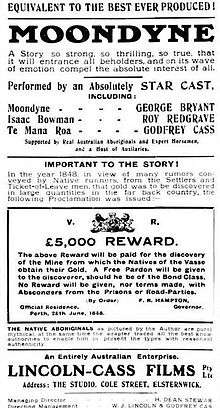Moondyne
| Author | John Boyle O'Reilly |
|---|---|
| Country | United States |
| Language | English |
| Genre | Novel |
| Publisher | P. J. Kennedy |
Publication date | 1879 |
| Media type | Print (Hardback & Paperback) |
| Wikisource has original text related to this article: |
Moondyne is an 1879 novel by John Boyle O'Reilly. It is loosely based on the life of the Western Australian convict escapee and bushranger Moondyne Joe.
O'Reilly was a Fenian revolutionary who was transported as a convict to Western Australia. During his time in Western Australia's penal system he would have heard many stories of Moondyne Joe's exploits, although it almost certain that the two men never met. After thirteen months in Western Australia, O'Reilly escaped the colony on board the American whaling ship Gazelle. He arrived in America in 1869 and settled in Boston, where he established himself as a respected journalist, newspaper editor, novelist and poet.
In 1913, film director W. J. Lincoln made a silent film of the same name.
Publication details
The novel Moondyne originally appeared as a serial in O'Reilly's newspaper The Pilot in 1878, under the title Moondyne Joe. Applauded by critics, it was published and republished under a variety of titles including:
- Moondyne Joe: A Story from the Underworld[1]
- Moondyne: A Tale of Convict Life in Western Australia[2]
- Moondyne: A Story of Life in West Australia
- Moondyne: An Australian Tale
- Moondyne, or, The Mystery of Mr Wyville
- The Golden Secret, or Bond and Free
- The Moondyne
- A Tale of Bush and Convict Life
- An Múindín (Irish-language translation, 1931).
Plot summary
Moondyne Joe is a convict who escapes after being victimised and mistreated by a cruel penal system. While on the run he is befriended by a tribe of aborigines who share with him their secret of a huge gold mine. Joe uses his new-found wealth to return to England and become a respected humanitarian under the assumed name Wyville. Recognised as possessing expertise in penal reform, he is ultimately sent back to Western Australia to help reform the colony's penal system. In the course of this he becomes involved in several subplots including the case of a young woman named Alice Walmsley who has been wrongly convicted of murdering her own child. Wyville/Moondyne succeeds in saving Alice from false imprisonment, helps to reform Western Australia's penal system, and achieves a number of other admirable ends before dying trying to save Alice and Sheridan from bushfires.
1913 film
| Moondyne | |
|---|---|
 Advertisement for film | |
| Directed by | W. J. Lincoln |
| Written by |
John Boyle O'Reilly W.J. Lincoln[3] |
| Based on | novel by John Boyle O'Reilly |
| Starring |
George Bryant Godfrey Cass Roy Redgrave |
| Cinematography | Maurice Bertel |
Production company | |
Release dates | |
Running time | 3,000 feet[6] |
| Country | Australia |
| Language |
Silent film English intertitles |
In 1913, the Melbourne-based Lincoln-Cass Film Company produced Moondyne, a black and white silent film based on O'Reilly's novel.[7][8] It is considered a lost film.[9]
Plot
In 1848, convict Joe is assigned as a labourer to settled Isaac Bowman in Western Australia. Joe escapes and takes refuge with a tribe of aborigines led by Te Mana Roa, who tell him about a mountain of gold.
Bowman recaptures Joe, who tells him about the mine. Bowman goes to the mine, kills the chief and loads his horse with gold, but ends up perishing in the desert, leaving Joe with his aboriginal friends.[10]
Cast
- George Bryant as Joe Moondye;
- Roy Redgrave as Isaac Bowman
- Godfrey Cass as Te Mana Roa.
Production
The film was shot in and around Melbourne.
Reception
According to one review:
The true story of Joe Gilchrist, though poetised in the drama to some extent, affords scope for much dramatic feeling and scenic display, and the many views of Australian scenery are delightful. The acting is vigorous and full of character, and the photographic work sharp and clear. Generally, it may be said that 'Moondyne' is quite up to American and European standard, and should command much attention in other parts of the world.[11]
See also
References
- ↑ "Moondyne Joe: A Story from the Underworld". Google Books (partial preview only). Retrieved 2 June 2014.
- ↑ "Moondyne; a story of convict life in Australia (ca. 1909?)". archive.org. Retrieved 2 June 2014.
- ↑ Copyright documentation relating to script at National Archives of Australia
- ↑ Mary Bateman, 'Lincoln Cass Filmography', Cinema Papers, June–July 1980 p 175
- ↑ "ENTERTAINMENTS.". The Argus (Melbourne, Vic. : 1848 - 1956). Melbourne, Vic.: National Library of Australia. 6 September 1913. p. 20. Retrieved 14 April 2012.
- ↑ "Advertising.". Williamstown Chronicle (Vic. : 1856 - 1954). Vic.: National Library of Australia. 4 October 1913. p. 5. Retrieved 3 February 2012.
- ↑ "Moondyne (film)]". AustLit. Retrieved 2 June 2014.
- ↑ "Moondyne (1913)". Internet Movie Database (IMDb). Retrieved 9 June 2006.
- ↑ "Advertising.". Williamstown Chronicle (Vic. : 1856 - 1954). Vic.: National Library of Australia. 4 October 1913. p. 6. Retrieved 3 February 2012.
- ↑ ""MOONDYNE".". Williamstown Chronicle (Vic. : 1856 - 1954). Vic.: National Library of Australia. 4 October 1913. p. 4. Retrieved 14 April 2012.
- ↑ "Royal Pictures.". The Prahran Telegraph (Vic. : 1889 - 1930). Vic.: National Library of Australia. 6 September 1913. p. 5. Retrieved 7 July 2015.
Further reading
- Ashton, Susanna M. (Spring 2002). "O'Reilly and the Moondyne". History Ireland. 10 (1): 38–42.
- Since 2002, an edited and annotated edition of Moondyne has been available online through University College Cork's Corpus of Electronic Texts (CELT). See especially the Preamble.